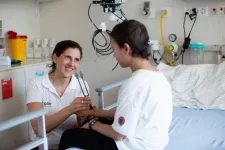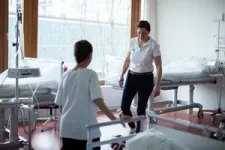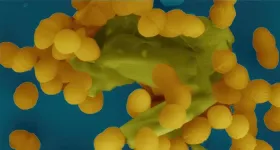(Press-News.org) Cancer treatments often cause nerve damage that can lead to long-lasting symptoms. Medication has proven ineffective in these cases. A sports scientist at the University of Basel, together with an interdisciplinary team from Germany, has now shown that simple exercises can prevent nerve damage.
Cancer therapies have improved over the years. It is no longer just about sheer survival: quality of life after recovery is gaining more importance.
Unfortunately, many cancer medications, from chemotherapy to modern immunotherapies, attack the nerves as well as the tumor cells. Some therapies, such as oxaliplatin or vinca alkaloids, leave 70 to 90 percent of patients complaining of pain, balance issues, or feelings of numbness, burning or tingling. These symptoms can be very debilitating. They can disappear following cancer treatment, but in around 50 percent they become chronic. Specialists call it chemotherapy-induced peripheral neuropathy, or CIPN for short.
A research team led by sports scientist Dr. Fiona Streckmann from the University of Basel and the German Sport University Cologne has now shown that specific exercise, concomitant to cancer therapy, can prevent nerve damage in many cases. The researchers have reported their findings in the journal JAMA Internal Medicine.
Exercise alongside chemo
The study involved 158 cancer patients, both male and female, who were receiving treatment either with oxaliplatin or vinca-alkaloids. The researchers divided the patients at random into three groups. The first was a control group, whose members received standard care. The other two groups completed exercise sessions twice a week for the duration of their chemotherapy, with each session lasting between 15 and 30 minutes. One of these groups carried out exercises that focused primarily on balancing on an increasingly unstable surface. The other group trained on a vibration plate.
Regular examinations over the next five years showed that in the control group around twice as many participants developed CIPN as in either of the exercise groups. In other words, the exercises undertaken alongside chemotherapy were able to reduce the incidence of nerve damage by 50 to 70 percent. In addition, they increased the patients’ subjectively perceived quality of life, made it less necessary to reduce their dose of cancer medications, and reduced mortality in the five years following chemotherapy.
The participants receiving vinca-alkaloids and performing sensorimotor training, had the largest benefit.
Ineffective medications
A lot of money has been invested over the years in reducing the incidence of CIPN, explains Streckmann. “This side effect has a direct influence on clinical treatment: for example, patients may not be able to receive the planned number of chemotherapy cycles that they actually need, the dosage of neurotoxic agents in the chemotherapy may have to be reduced, or their treatment may have to be terminated.”
Despite the investments made, there is no effective pharmacological treatment to date: various studies have shown that medications can neither prevent nor reverse this nerve damage. However, according to the latest estimates, USD 17,000 are spent per patient every year in the USA on treating nerve damage associated with chemotherapy. Streckmann’s assumption is that “doctors prescribe medications despite everything, because patients’ level of suffering is so high.”
Study ongoing in children’s hospitals
In contrast, the sports scientist emphasizes, the positive effect of exercise has been substantiated, and this treatment is very cheap in comparison. At the moment she and her team are working on guidelines for hospitals, so that they can integrate the exercises into clinical practice as supportive therapy. In addition, since 2023 a study has been ongoing in six children’s hospitals in Germany and Switzerland (PrepAIR), which is intended prevent sensory and motor dysfunctions in children receiving neurotoxic chemotherapy.
“The potential of physical activity is hugely underestimated,” says Fiona Streckmann. She very much hopes that the results of the newly published study will lead to more sports therapists being employed in hospitals, in order to better exploit this potential.
END
Physical exercise prevents nerve damage during chemotherapy
2024-07-01
ELSE PRESS RELEASES FROM THIS DATE:
Scientists turn white fat cells into calorie-burning beige fat
2024-07-01
New UCSF study shows that suppressing a protein turns ordinary fat into a calorie burner and may explain why drug trials attempting the feat haven’t been successful.
Researchers at UC San Francisco have figured out how to turn ordinary white fat cells, which store calories, into beige fat cells that burn calories to maintain body temperature.
The discovery could open the door to developing a new class of weight-loss drugs and may explain why clinical trials of related therapies have ...
How politicizing migration harms health
2024-07-01
Politicians around the world are increasingly mobilizing anti-immigrant sentiment to garner support and votes—a trend that is especially evident as the US presidential election approaches.
While political rhetoric that stereotypes and scapegoats immigrants is well-documented, less attention has been given to the impact of these sentiments on immigrants themselves. In an article published today in the Journal of the American Medical Association (JAMA) and in a recently published book, Migration Stigma (MIT Press), scholars identify “migration ...
Excess US deaths attributable to high all-cause mortality rates among youths
2024-07-01
About The Study: The mortality gap between the U.S. and comparison countries widened in the last decade. Each year, nearly 20,000 deaths among youths ages 0 to 19 years would not have occurred had U.S. youths experienced the median mortality rates of 16 comparison countries. More than half of these deaths involved infants, reflecting disproportionately high U.S. infant mortality rates.
Corresponding Author: To contact the corresponding author, Steven H. Woolf, M.D., M.P.H., email steven.woolf@vcuhealth.org.
To access the embargoed study: Visit our For The Media website at this link https://media.jamanetwork.com/
(doi:10.1001/jamapediatrics.2024.1869)
Editor’s ...
COVID-19 vaccination in the first trimester and major structural birth defects among live births
2024-07-01
About The Study: Among live-born infants, first-trimester mRNA COVID-19 vaccine exposure was not associated with an increased risk for selected major structural birth defects in this multisite cohort study.
Corresponding Author: To contact the corresponding author, Elyse O. Kharbanda, M.D., M.P.H., email elyse.o.kharbanda@healthpartners.com.
To access the embargoed study: Visit our For The Media website at this link https://media.jamanetwork.com/
(doi:10.1001/jamapediatrics.2024.1917)
Editor’s Note: Please see the article for additional ...
Dehumanizing rhetoric on immigration harms public health
2024-07-01
With Donald Trump and other right-wing politicians increasingly using dehumanizing rhetoric to stigmatize immigrants coming to our nation's borders, doctors and other health officials should prepare for the resulting health consequences.
Such is the message of a “Viewpoint” article co-authored by UC Riverside professor Bruce Link and published Monday, July 1, in the Journal of the American Medical Association.
Link and his co-authors quote Trump as saying, “No, they’re not humans. They’re not humans. They’re ...
A prosthesis driven by the nervous system helps people with amputation walk naturally
2024-07-01
State-of-the-art prosthetic limbs can help people with amputations achieve a natural walking gait, but they don’t give the user full neural control over the limb. Instead, they rely on robotic sensors and controllers that move the limb using predefined gait algorithms.
Using a new type of surgical intervention and neuroprosthetic interface, MIT researchers, in collaboration with colleagues from Brigham and Women’s Hospital, have shown that a natural walking gait is achievable using a prosthetic leg fully driven by the body’s own nervous system. ...
Novel blood test helps improve cancer treatments
2024-07-01
The earlier a cancer is detected, the better the chances that treatment will be effective. This applies to almost all types of cancer. Another crucial element in successfully treating patients is to individually assess the benefits and risks of individual forms of therapy and to regularly monitor treatment success. To do this, oncologists have a range of methods at their disposal, most notably imaging technology and invasive measures such as tissue biopsies, punctures and endoscopic procedures.
Analyzing gene fragments in the bloodstream
Researchers ...
Research-driven Korea University College of Medicine promotes joint research with global scholars
2024-07-01
Korea University's College of Medicine (Dean Pyun, Sung Bom) hosted the 1st Research Nexus Program in order to enhance international research network cooperation and vitalize global joint research.
This program shares the latest research trends and aims to invigorate international joint research by opening a seminar inviting top global scholars to promote international research performances.
The 1st program held an invitation seminar of Prof. Jeffrey D. Macklis, the "global authority in the field of neurogenesis" (Department of Stem Cell and Regenerative Biology at Harvard University).
Prof. Macklis ...
Degradation of cell wall key in the spread of resistance
2024-07-01
A study at Umeå University, Sweden, provides new clues in the understanding of how antibiotic resistance spreads. The study shows how an enzyme breaks down the bacteria's protective outer layer, the cell wall, and thus facilitates the transfer of genes for resistance to antibiotics.
"You could say that we are adding a piece of the puzzle to the understanding of how antibiotic resistance spreads between bacteria," says Ronnie Berntsson, Associate Professor at Umeå University and one of the authors behind the study.
The Umeå researchers have studied Enterococcus faecalis, which is a bacterium that often ...
The evidence is mounting: humans were responsible for the extinction of large mammals
2024-07-01
The debate has raged for decades: Was it humans or climate change that led to the extinction of many species of large mammals, birds, and reptiles that have disappeared from Earth over the past 50,000 years?
By "large," we mean animals that weighed at least 45 kilograms – known as megafauna. At least 161 species of mammals were driven to extinction during this period. This number is based on the remains found so far.
The largest of them were hit the hardest – land-dwelling herbivores weighing over a ton, the megaherbivores. Fifty thousand years ago, there were 57 species of megaherbivores. Today, only 11 remain. These remaining ...





